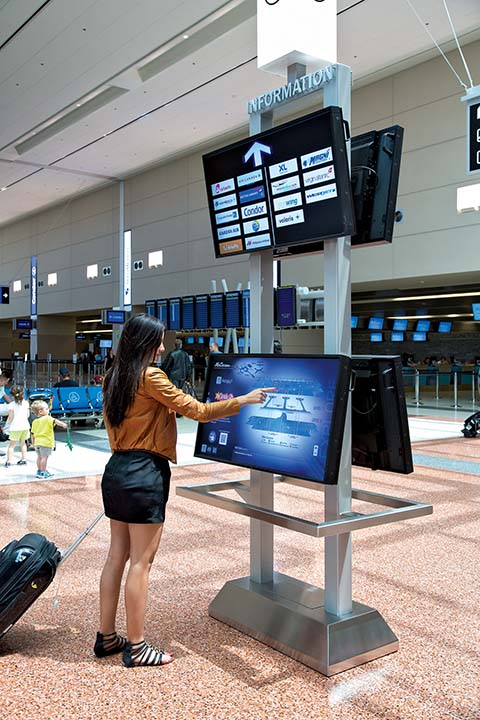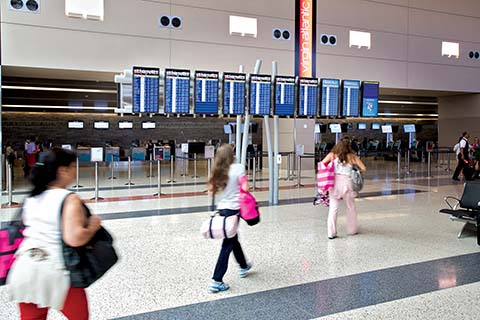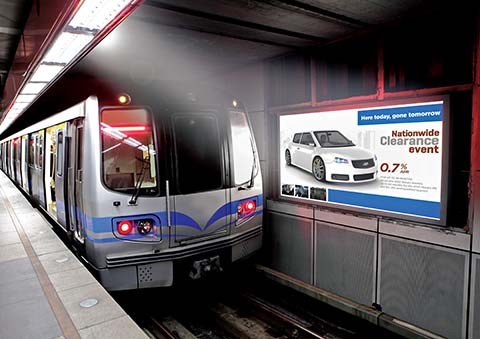Digital Signage: Flying high in the transportation sector
by all | 5 November 2015 12:09 pm
 [1]
[1]Photos courtesy NEC Display Solutions
By Keith Yanke
The global market for digital signage is expected to be worth nearly $4.5 billion U.S. in 2016. At the same time, information technology (IT) spending in the transportation sector has been increasing each year. These two trends are not mutually exclusive; indeed, when one is travelling, there seems to be digital signage everywhere, from screens in taxis and buses to flight information display systems (FIDSs) displaying arrival and departure times in airports’ waiting areas, though there are also many spaces yet untouched.
The transportation sector—spanning airports, train stations, bus depots and other facilities—has specific needs with respect to digital messaging. Officials must carefully consider software, displays, media players, mounting systems and content, among other factors.
Built to last
Professional, commercial-grade displays are essential in transportation environments, as they tend to be operated for 20 to 24 hours a day—it is very rare for them to be turned off—and for years on end. Ultimately, the length of use will depend on the specific property and its management; some clients fully refresh their displays after only a few years, but five years is generally the minimum period before screens are replaced.
The commercial grade of a digital display begins with its mechanical design, including a heavy-duty internal and external metal chassis, with protection against environmental conditions in mind. Airflow is also important to ensure continuous operation—consumer-grade TVs, by comparison, offer none.
Also, digital signage displays are not just used indoors. There is increasing demand to reach travellers and visitors with information and advertising before they step into a transportation facility. The growing frequency of outdoor and semi-outdoor screen installations means there are more variables to address in terms of durability when choosing the right systems.
Some screens are protected by integrating them into outdoor enclosures, which are usually custom designs, but share features like air conditioning to protect the internal electronics against heat and humidity. Another option is to integrate a screen into a kiosk, which offers its own ingress protection (IP) against liquid and solid particles for digital signage applications in outdoor or semi-outdoor locations. Some displays are themselves outdoor-rated, with no need for an additional enclosure.
Another factor is brightness. Many transportation facilities are designed to let in plenty of natural light, which can make for a challenging ambient environment for viewing digital displays unless they are high-brightness (HB) models.
Vandalism it not typically a problem in airports and transit stations, but some display enclosures are ballistic- and vandal-resistant. They may come with outer layers of film that, if spraypainted with graffiti, can simply be removed and replaced.
Given how busy transportation facilities can be at all hours, remote control and monitoring of the screens must be supported. It is also preferable to push out all on-screen content from one location within the facility, so there is no inconsistency.
Multi-purpose networks
The potential uses of digital signage in a transportation facility may be very numerous because of the facility’s many business goals.
 [2]
[2]Flight information display systems (FIDSs) are among the most common implementations of digital signage in the transportation sector.
The primary purpose of transporting commuters efficiently, for example, is supported by displaying schedules, emergency alerts, procedures, wayfinding information and visual paging. Secondarily, as a gateway to the local community, the facility may use digital signage to promote tourist attractions, future travel opportunities and reward programs. Third-party tenants, meanwhile, use digital signage to enhance passengers’ dwell-time experience by promoting food and beverages, shopping and entertainment, which in turn help generate additional revenue for the facility.
Indeed, one of the benefits of digital signage to airports has been to increase the revenue earned per passenger. At the same time, the medium can enhance customer service, alleviate passengers’ anxiety by reassuring them with the right information in the right place, help make business processes more efficient and build customer loyalty.
Incorporating interactivity
One growing digital signage trend in the transportation sector is the installation of interactive video walls, which can engage commuters in large, open areas. Assembling an array of narrow-bezel LCDs for this purpose is less expensive than buying one giant screen. Depending on the application, single- or multi-touch—or even gesture-based—interactivity can be supported.
 [3]
[3]Tough, commercial-grade displays are essential in transportation environments.
Interactivity can also be offered through the display of Quick Response (QR) codes, near field communication (NFC) or other technologies for connecting with mobile devices. In the U.K., for example, retail chain Tesco set up refrigerator-shaped kiosks at Gatwick Airport that allowed travellers to order groceries for delivery to their homes. Integrating both touch screens and scannable codes, the kiosks saw nearly 3,800 touch activations over two weeks, with a nearly five-minute average interaction time among passengers, 50 per cent of whom made a purchase.
Another way to foster connectivity is to tie messaging to social media, encouraging passengers to use Twitter, Facebook or other social networks to receive relevant updates in the future. In New York, N.Y., for example, a one-month interactive digital signage campaign in Times Square for New York Water Taxi (NYWT) prompted tourists to take their photo at a touch-screen kiosk, share it online and then buy tour tickets from their own devices. Nearly 12,150 touch activations throughout the campaign led to sales of more than 3,750 tickets at $20 U.S. each.
Leading the way
In many ways, airports have led the way in optimizing the use of digital signage. They tend to earn more digital out-of-home (DOOH) advertising revenue than shopping malls, for example, even though the numbers of people who pass through them are roughly the same (see Sign Media Canada, September 2014[4]).
Today, ground-based transportation facilities are moving in the same direction, replicating the airport business model so as to enjoy the same long-term sustainability funding. While their efforts in North America have been limited so far, many European train stations have successfully mimicked airports’ digital signage infrastructure.
As the prices of digital signage technologies continue to fall, the medium will continue to become achievable in more and more environments, especially those within the transportation sector, where customers are enjoying a richer overall experience, rather than simply rushing to make their trip.
Keith Yanke is senior director of product marketing for NEC Display Solutions. For more information, visit www.necdisplay.com[5].
- [Image]: http://www.signmedia.ca/wp-content/uploads/2015/11/McCarran13_CMYK_300-copy.jpg
- [Image]: http://www.signmedia.ca/wp-content/uploads/2015/11/McCarran8_CMYK_300-copy.jpg
- [Image]: http://www.signmedia.ca/wp-content/uploads/2015/11/PJ-SubwayTrainAd21.jpg
- Sign Media Canada, September 2014: http://www.kenilworth.com/publications/smc/de/201409/files/46.html
- www.necdisplay.com: http://www.necdisplay.com/
Source URL: https://www.signmedia.ca/digital-signage-flying-high-in-the-transportation-sector/